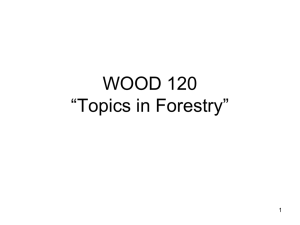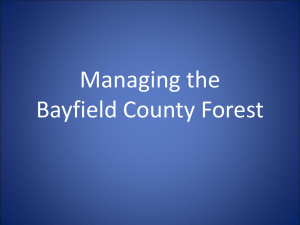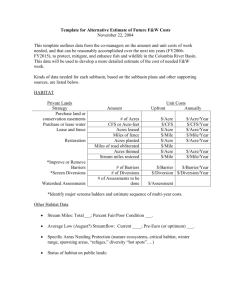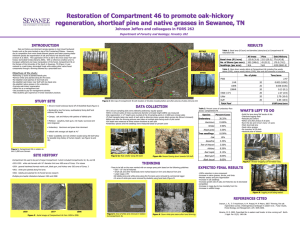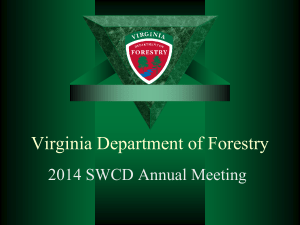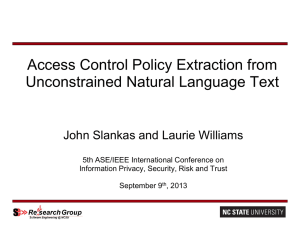Supplementary Materials for Environmental Management
advertisement
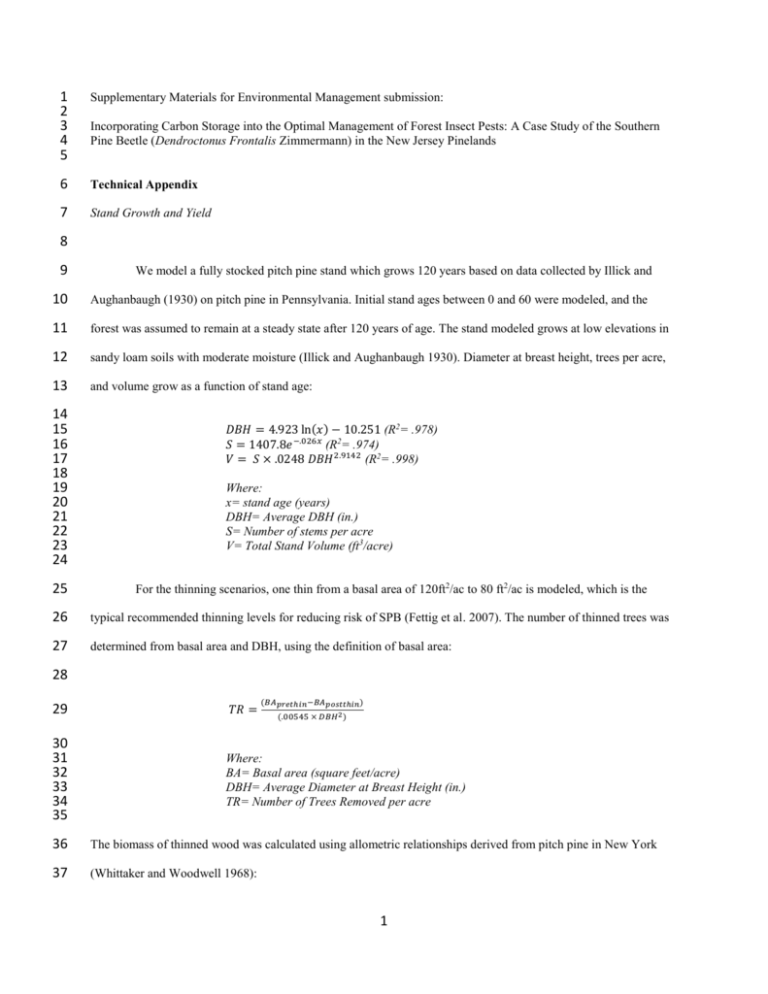
1 2 3 4 5 Supplementary Materials for Environmental Management submission: 6 Technical Appendix 7 Stand Growth and Yield Incorporating Carbon Storage into the Optimal Management of Forest Insect Pests: A Case Study of the Southern Pine Beetle (Dendroctonus Frontalis Zimmermann) in the New Jersey Pinelands 8 9 We model a fully stocked pitch pine stand which grows 120 years based on data collected by Illick and 10 Aughanbaugh (1930) on pitch pine in Pennsylvania. Initial stand ages between 0 and 60 were modeled, and the 11 forest was assumed to remain at a steady state after 120 years of age. The stand modeled grows at low elevations in 12 sandy loam soils with moderate moisture (Illick and Aughanbaugh 1930). Diameter at breast height, trees per acre, 13 and volume grow as a function of stand age: 14 15 16 17 18 19 20 21 22 23 24 25 𝐷𝐵𝐻 = 4.923 ln(𝑥) − 10.251 (R2= .978) 𝑆 = 1407.8𝑒 −.026𝑥 (R2= .974) 𝑉 = 𝑆 × .0248 𝐷𝐵𝐻 2.9142 (R2= .998) Where: x= stand age (years) DBH= Average DBH (in.) S= Number of stems per acre V= Total Stand Volume (ft3/acre) For the thinning scenarios, one thin from a basal area of 120ft2/ac to 80 ft2/ac is modeled, which is the 26 typical recommended thinning levels for reducing risk of SPB (Fettig et al. 2007). The number of thinned trees was 27 determined from basal area and DBH, using the definition of basal area: 28 (𝐵𝐴𝑝𝑟𝑒𝑡ℎ𝑖𝑛 −𝐵𝐴𝑝𝑜𝑠𝑡𝑡ℎ𝑖𝑛) 29 𝑇𝑅 = 30 31 32 33 34 35 Where: BA= Basal area (square feet/acre) DBH= Average Diameter at Breast Height (in.) TR= Number of Trees Removed per acre (.00545 × 𝐷𝐵𝐻 2 ) 36 The biomass of thinned wood was calculated using allometric relationships derived from pitch pine in New York 37 (Whittaker and Woodwell 1968): 1 38 39 40 41 42 43 44 45 𝑂𝐷𝐵 = ( .1040𝐷𝐵𝐻 2.3373 ) × 𝑇𝑅 Where: ODB= Oven Dry Above-ground Biomass (kg/acre) DBH= Diameter at breast height (cm) TR= Number of Trees removed per Acre 46 Basal area and thus the weighted incidence probabilities are recalculated after thinning using growth and 47 yield relationships. Because the effects of thinning on growth rates of remaining trees in pitch pine stands in New 48 Jersey has not been studied, DBH growth rates of trees are adjusted to increase .01 in. per year after thinning. This 49 estimate was based on the range of increased growth rates from data of shortleaf and loblolly stands in the South 50 (Feduccia et al. 1979; Mann 1952). 51 52 Southern Pine Beetle Infestations and Ecological Data 53 54 55 This study considers a weighted incidence probability used in previous literature, as well as regional SPB population levels and climate to stochastically generate SPB infestations through Monte Carlo simulations. 56 57 Weighted Incidence Probability: We consider a model in which the risk of a Southern Pine Beetle attack increases 58 as a function of basal area of a stand, according to the Daniel’s (1979) incidence probability function: 59 60 61 1 𝑃𝐷𝐾 = 1 + 𝐸𝑋𝑃(4.829 − (. 0519 ∗ ( 62 63 64 65 66 67 ( 𝐵𝐴 )) − (4.062 ∗ (%𝑃𝑆𝐶)) 4.356 ) Where: PDK= Daniels Incidence Probability for stand BA= Basal area (m2/ac) %PSC= Percent pine composition of stand 68 This incidence probability has been used in previous models of SPB pestilence (Costanza et al. 2012; Burkhart et al. 69 1986). Percent pine composition of the stand is assumed to be a constant 80% as in Reed et al. (1982). 70 71 The Daniels function estimate is “unweighted,” or it assumes that there are an equal number of infested and un-infested stands in a region. Thus, it must be adjusted for region-wide infestation risk or the average number of 2 72 infested stands of host type across the region during an outbreak year. In order to weight this function, we use a 73 similar weighting system as Naumann (2012) to adjust the Daniels et al. (1979) probability function by the New 74 Jersey regional risk: 75 𝑃𝑠 𝑃̅𝐷 76 𝑃𝑘 = 𝑃𝐷𝑘 ∗ 77 78 79 80 81 82 83 Where: Pk = probability of mortality from SPB Ps= regional SPB risk PDk= Daniels probability 𝑃̅𝐷 = average Daniels probability for stand 84 New Jersey regional SPB risk was determined through an ArcGIS analysis of New Jersey Department of 85 Environmental Protection SPB spot data between 2002 and 2011 over outbreak years and New Jersey Department of 86 Environmental Protection Land Use Land Cover (LULC) 2007 data on forest types. Stands were assumed to have 87 similar species composition between 2002-2011 as they had when they were surveyed in 2007. The regional SPB 88 risk, measured in median infested acres/ acre of host type for outbreak years, was calculated assuming that any 89 stands with greater than 50% conifer composition were host stands. 90 91 Regional SPB Populations: In this model, each year was stochastically determined to be an “outbreak year,” in 92 which the weighted incidence probability was invoked, or an “endemic year,” in which SPB populations were 93 assumed to be so low that no forest damage occurred. In endemic years, the weighted incidence probability was 94 assumed to be 0. We modeled high, medium, and low SPB population levels, in which 80%, 50%, and 20% of years 95 modeled, respectively, were outbreak years. 96 97 Climate: Climate, another factor that is not typically incorporated into economic analyses of SPB infestations, is 98 also incorporated into this model for greater biological accuracy. Studies have projected that future climate change 99 may increase SPB infestation risk in certain areas by 2.5-5 times (Gan, 2004). Minimum winter temperature (MWT) 100 was modeled in this study because it is the most well-known regulating factor of SPB outbreak, since notable winter 101 mortality occurs when temperatures drop below -12°C and beetles freeze (Lombardero et al. 2000a). Tran et al. 3 102 (2007) found that if the coldest winter night dropped below -16°C, the probability of a decrease in SPB population 103 was 65%. If temperatures dropped below -20°C, then there was an 80% likelihood that populations significantly 104 declined. This study thus assumed the same criteria as Tran et al. (2007). 105 106 Volumetric Losses and Severity: If a stand is determined to be infested based on the incidence probability, climate, 107 and regional outbreak, we assume that a “spot” or growing infestation will develop that affects a proportion of the 108 stand. We assume that suppression will stop spot growth after 45 days (Burkhart et al. 1986) while no management 109 will allow spot growth to continue throughout the summer (Fettig et al. 2007), which we modeled as being 120 days. 110 Many studies of SPB in the South have documented that spot growth and thus volumetric losses from SPB vary with 111 basal area, DBH and other stand parameters (Lorio et al. 1982; Nebeker et al. 1985). Thus, we used the Reed et al. 112 (1981) severity function derived from data in Texas to model spot growth over the 45 or 120 day period of spot 113 growth: 𝑇𝐵𝐴 𝑙𝑛(𝑇𝐾𝐷) = 3.43 + .965𝑙𝑛(𝐴𝑇) − 2.85𝑙𝑛(𝐷𝐵𝐻) − 22.13( ) + .074𝑇𝐵𝐴 + .5576𝑃𝑂𝑃 𝐷𝐵𝐻 2 114 115 116 117 118 119 120 121 122 123 As in Burkhart et al. (1986) we assume the initial spot size is .05 acres so the number of initial attacked trees is 124 derived from stand density at the time of infestation. Volumetric losses are then calculated using the following 125 formula, based on Burkhart et al. (1986) and pitch pine growth and yield from Illick and Aughenbaugh (1930): 126 Where: TKD= Trees killed per day AT=Number of initial attacked trees DBH= Diameter at breast height (cm) TBA= Total Basal Area (m2/ha) POP= annual number of spots/405 ha of host trees for entire region/year 𝑉𝐿 = (𝐴𝑇 + (𝑇𝐾𝐷 ∗ 𝐷)) ∗ .0248 ∗ (𝐷𝐵𝐻 2.9143 ) Where: TKD= Trees killed per day AT=Number of initial attacked trees DBH= Diameter at breast height (cm) D= Days of spot growth 127 128 129 130 131 132 133 Once volumetric losses are calculated, the proportion of the stand infested, or the “sub-stand” is reset to stand age of 134 zero while the remaining proportion of the stand continues growing unharmed. Basal areas and thus infestation 135 probabilities are then weighted based on the proportion of the stand each “sub-stand” represents. We assume our 136 stand is infested a maximum of seven times in the 120 year modeling period. 4 137 138 Incorporating and Valuing Carbon Sequestration 139 140 Following Gutrich and Howarth’s (2007) model, carbon storage is determined from four main components: 141 live above ground biomass, root biomass, soil, and dead and downed wood. Carbon is then valued assuming a future 142 global carbon emissions and offsets trading market, as in Gutrich and Howarth (2007), and incorporated into 143 economic analyses using social net present value calculations. 144 145 Live Biomass: Carbon in live biomass is calculated from total above and below ground biomass of trees using the 146 50% rule, which is the default used in IPCC reports. This rule states that standing live carbon content of a stand is 147 approximately 50% of oven-dry biomass ( Brown and Lugo 1982). As was followed in Lathrop et al.’s (2011) 148 analysis of carbon sequestration in New Jersey, below ground, or root biomass, was assumed to be directly related to 149 above ground biomass, using relationships developed by Cairns et al. (1997): 150 151 𝑅𝐵 = 𝐸𝑋𝑃(−1.085 + .926𝐿𝑛(𝐴𝐺𝐵)) 152 153 154 155 156 where: RB= Root Biomass (tons/acre) AGB= Above ground Biomass (tons/acre) 157 Soil Carbon: Soil carbon was assumed to be independent of management as in Gutrich and Howarth (2007) and thus 158 assumed to be a constant value of 20 tons/acre in this study. This figure was derived from Lathrop et al. (2011), who 159 found from USDA Soil Survey Geographic (SSURGO) database and Forest Inventory and Analysis data that soil 160 carbon density in the Pinelands ranged from between 20 and 75 tons/ acre. The highest soil carbon densities were 161 found in poorly drained soils of coastal wetland areas, while the lowest soil carbon densities were found in the drier 162 soils of the Uplands, which most closely resembled the soil conditions of the stands modeled in Illick and 163 Aughanbaugh (1930). 164 5 165 Dead and Downed Wood: Carbon in dead and downed wood was determined from an equation developed by 166 Gutrich and Howarth (2007), which allows dead and downed wood to decay at a certain rate each year and new dead 167 biomass to be added each year to the dead and downed wood stock: 168 169 170 171 172 173 174 175 𝐶𝑑𝑒𝑎𝑑 = (1 − 𝜕0 )[𝐶𝑑𝑒𝑎𝑑 (𝑡 − 1) + 𝜕1 𝐶𝑙𝑖𝑣𝑒 (𝑡 − 1)𝜕2 ] where: 𝐶𝑑𝑒𝑎𝑑 = Carbon in dead/ downed wood (tons) 𝜕0 = Decay rate of dead/downed wood (%/year) 𝜕1 , 𝜕2 =Formation coefficients for dead/ downed wood 176 Formation and decay rates of dead and downed wood determined by Gutrich and Howarth from Forest Inventory 177 and Analysis data for red/white/jack pine in the Northeast were used, as no data existed for pitch pine in New Jersey. 178 It was assumed that carbon converted into mulch from thinning or cut and remove suppression was completely 179 released within a year after mulching, and trees left from cut and leave suppression were added as dead and downed 180 wood and decayed at the same rate as other dead and downed wood. 181 182 Carbon Valuation: As discussed in the manuscript, increasingly, the social costs of carbon- and thus the value of 183 carbon sequestration- are increasingly being considered in forest management. The value of carbon, or the marginal 184 benefit of a ton of carbon sequestered, can be determined from the social costs of carbon over time using an 185 Integrated Assessment Model, which uses an aggregate damage function to determine prices of carbon under future 186 emissions scenarios. We used the 2007 version of the DICE integrated assessment model (Nordhaus, 2008) to 187 determine marginal benefits over time in two potential future policy scenarios. In the first policy scenario, or the 188 “low marginal benefits of carbon scenario,” we assume climate mitigation aims to maximize net benefits and 189 marginal benefits of carbon increase over time according to the following equation: 190 191 192 193 194 195 196 𝑀𝐵𝑙𝑜𝑤 = 39.874 ∗ 𝐸𝑋𝑃(. 0167𝑡) where: MBlow= Marginal benefits of Carbon ($/ton) t= time (years) 6 197 In the second policy scenario, or the “high marginal benefits of carbon” scenario, we assume emissions 198 abatement programs prevent more than a 2 degree F increase in global mean temperatures over the next century; 199 thus, marginal benefits of carbon increase over time according to the following equations: 200 201 202 203 204 205 206 207 208 For t<80, For t>80, 𝑀𝐵ℎ𝑖𝑔ℎ = 72.987 ∗ 𝐸𝑋𝑃(.0336𝑡) 𝑀𝐵ℎ𝑖𝑔ℎ = .23267𝑡 2 − 50.217𝑡 + 3451.1 Where: MBhigh= Marginal benefits of Carbon ($/ton) t= time (years) Private and Social Net Present Value Calculations: 209 210 Without considering carbon sequestration or other ecosystem services, a rational forest manager would 211 choose to follow the SPB management scenario that would maximize net benefits from chips and mulch, or the 212 private net present value: 213 214 215 216 217 218 219 220 221 222 223 224 225 120 𝑡 𝑁𝑃𝑉𝑝𝑟𝑖𝑣𝑎𝑡𝑒 = ∑(𝑅𝑡ℎ𝑖𝑛 − 𝐶𝑡ℎ𝑖𝑛 + 𝑅𝑠𝑢𝑝𝑝𝑟𝑒𝑠𝑠𝑖𝑜𝑛 − 𝐶𝑠𝑢𝑝𝑝𝑟𝑒𝑠𝑠𝑖𝑜𝑛 ) ∏ 𝑡=0 𝑖=1 1 (1 + 𝑟(𝑖)) Where: 𝑅𝑡ℎ𝑖𝑛 = Revenue from 1 acre of thinning 𝐶𝑡ℎ𝑖𝑛 = Costs/acre of thinning 𝑅𝑠𝑢𝑝𝑝𝑟𝑒𝑠𝑠𝑖𝑜𝑛 = Revenue/ acre of suppression 𝐶𝑠𝑢𝑝𝑝𝑟𝑒𝑠𝑠𝑖𝑜𝑛 = Costs/acre of suppression r(i) = discount rate t= time (years) The Private NPV is calculated as zero unless the basal area of the stand exceeds 120 square feet per acre 226 and the stand is thinned or if the stand is stochastically determined to be infested that year. Marginal benefits derived 227 from chips and mulch were determined from an internet search of mulch and chip prices; the majority of the 228 contractors interviewed conducting SPB management were in the business as developers and land clearers, so the 229 marginal benefits from mulch and chips derived from costs avoided from having to buy mulch and chips for 230 developments. Costs of thinning and suppression per acre were also determined from interviews with contractors in 231 NJ. Because cost estimates per acre were provided and the majority of infestations modeled were less than an acre, 232 we modeled scenarios in which costs of suppressing an infestation were 75% and 50% of costs/per acre. 7 233 234 When carbon sequestration is considered, net benefits derived from carbon, or the carbon net present value, can be calculated from the marginal benefits of carbon from global emissions and abatement schemes: 235 120 236 𝑁𝑃𝑉𝑐𝑎𝑟𝑏𝑜𝑛 = ∑ 𝑀𝐵(𝑡) ∗ ∆𝐶(𝑡) ∏ t=0 237 238 239 240 241 242 243 𝑡 i=1 1 (1 + 𝑟(𝑖)) Where: MB(t)= marginal benefit of a ton of carbon sequestered ∆𝐶(𝑡)=change in carbon stored (tons) from t to t+1 r(i)= discount rate t= time (years) In the case of a carbon emissions and offsets market, a rational forest manager would want to maximize the 244 social net present value, or the addition of the private and carbon net present values when managing for SPB 245 pestilence: 246 247 248 249 𝑁𝑃𝑉𝑠𝑜𝑐𝑖𝑎𝑙 = 𝑁𝑃𝑉𝑝𝑟𝑖𝑣𝑎𝑡𝑒 + 𝑁𝑃𝑉𝑐𝑎𝑟𝑏𝑜𝑛 Sensitivity and Scenario Analyses: 250 251 Sensitivity analyses were conducted by varying inputs parameters by 25%. In addition, sensitivity analyses 252 were conducted for 2%, 4%, 8%, and 12% discount rates and assuming that costs of suppression for each infestation 253 (which were under an acre) were 100%, 75%, and 50% the costs of suppression per acre. Formation and decay 254 coefficients of dead and downed wood as well as regional SPB risk had the greatest effect on mean Social NPV, as 255 well as regional SPB risk. Thus, scenario analyses were conducted with dead and downed wood formation and 256 decay coefficients from the literature derived from oak/pine and white/red pine. In addition, scenarios were 257 conducted by increasing regional SPB risk two, three, and six fold to assess under what conditions thinning would 258 be favored when both carbon and timber are considered. 259 At 100% the costs of suppression, the strategy that maximized Private NPV varied based on SPB 260 population levels and initial stand age. At 50% and 75% the costs of suppression per acre, thinning maximized 261 Private NPV at all stand ages in medium population levels. However, no management strategies still maximized 262 Social NPV. Formation coefficients for oak/pine did not affect optimal management results. 8 263 For every discount rate modeled, no management strategies maximized social NPV. However, for the 264 highest discount rate scenario (12%), social NPV for thinning scenarios exceeded that of suppression cut and leave 265 scenarios (Table S-1). 266 Social net present value of thinning scenarios also exceeded that of suppression only scenarios when 267 regional SPB population risk increased to six times that of current population levels or thinning completely 268 eradicated risk of SPB and regional SPB population risk increased to two times that of current levels. 269 270 271 272 Table S-1: For all discount rates, social net present value (NPV) ($/acre) is maximized for no management 273 scenarios. Discount rate No management (%/year) Suppression cut and Thinning and cut and leave leave suppression 2 1244 1181 892 4 924 886 791 8 510 486 479 2 339 315 322 274 275 276 277 References 278 279 Brown S, Lugo AE (1982) The storage and production of organic matter in tropical forests and their role in the 280 global carbon cycle. Biotropica 14:161-187 281 282 Burkhart HE, Haney Jr. HL, Newberry JD, Leuschner WA, Morris CL, Reed DD (1986) Evaluation of thinning for 283 reduction of losses from southern pine beetle attack in loblolly pine stands. South J Appl Forestry 10:105-108 284 9 285 Cairns MA, Brown S, Helmer E, Baumgardner GA (1997) Root biomass allocation in the world’s upland forests. 286 Oecologia 111:1-11 287 288 Costanza J, Huler J, Koch F, Earnhardt T, McKerrow A, Dunn P, Collazo J (2012) Stimulating the effects of the 289 southern pine beetle on regional dynamics 60 years into the future. Ecol Model 244:93-103 290 291 Feduccia DP, Dell TR, Mann WF Jr, Campbell TE, Palmer BH (1979) Yields of unthinned loblolly pine plantations 292 on cutover sites in the West Gulf Region, Res. Pap. SO-148. In: U.S. Department of Agriculture, Forest Service, 293 Southern Forest Experiment Station. New Orleans, Louisiana, p 88 294 295 Fettig CJ, Klepzig KD, Billings RF, Munson AS, Nebeker TE, Negron JF, and Nowak JT (2007) The effectiveness 296 of vegetation management practices for prevention and control of bark beetle infestations in coniferous forests of the 297 western and southern United States. Forest Ecol Manag 238:24–53 298 299 Gan JB (2004) Risk and damage of southern pine beetle outbreaks under global climate change. Forest Ecol Manag 300 191:61-71 301 302 Gutrich J, Howarth R (2007) Carbon sequestration and the optimal management of New Hampshire timber stands. 303 Ecol Econ 62:441-450 304 305 Howarth RB (2001) Intertemporal social choice and climate stabilization. Int J Environ Pollut 15:386–405 306 307 Illick JS, Aughanbaugh JE (1930) Pitch pine in Pennsylvania. Pennsylvania Department of Forestry and Waters 308 Research Bulletin 2 309 310 Lathrop R G, Clough B, Cottrell A, Ehrengeld J, Felder F, Green E.J, Specca D, Vail C, Vodak, M, Xu M., Zhang Y 311 (2011) Assessing the potential for New Jersey forests to sequester carbon and contribute to greenhouse gas 10 312 emissions avoidance. Rutgers, The State University of New Jersey. http://crssa.rutgers.edu/projects/carbon/. 313 Accessed 1 July 2013 314 315 Lombardero MJ, Ayres MP, Ayres BD, Reeve JD (2000a) Cold tolerance of four species of bark beetle (Coleoptera: 316 Scolytidae) in North America. Environ Entomol 29:421–432 317 318 Lorio P L Jr., Mason GN, Autry, GL (1982) Stand risk rating for the southern pine beetle: integrating pest 319 management with forest management. J Forest 80:212-214 320 Mann WF Jr. (1952) Thirty-six years of thinning research with loblolly pine. In: Proceedings, Louisiana State 321 University first annual forestry symposium, Baton Rouge, Louisiana, pp 1-7 322 Martinson S, Ylioja T, Sullivan B, Billings R, Ayres M (2012) Alternate attractors in the population dynamics of a 323 tree-killing bark beetle. Popul Ecol 55 (1):95 324 Naumann NB (2012) An economic assessment of stand-level treatments for southern pine beetle prevention. Master 325 of Science Dissertation, North Carolina State University Forestry and Environmental Resources. 326 327 Nebeker TE, Hodges JD, Karr BK, Moehring DM (1985) Thinning practices in southern pines--with pest 328 management recommendations. USDA Forest Service Technical Bulletin 1703:1-36 329 330 Nordhaus W (2008) A question of balance: weighing the options on global warming policies. New Haven, 331 Connecticut 332 333 Reed DD, Burkhart HE, Leuschner WA (1981) A Severity Model for Southern Pine Beetle Infestations. Forest Sci 334 27: 290-296 335 336 Reed DD, Hedden RL, Daniels RF (1982) Estimating the annual probability of southern pine beetle outbreak. Forest 337 Sci 28:202-206 11 338 339 Tran JK, Ylioja T, Billings R, Régnière J, Ayres MP (2007) Impact of minimum winter temperatures on the 340 population dynamics of Dendroctonus frontalis (Coleoptera: Scolytinae). Ecol Appl 17:882-899 341 342 Whittaker R H, Woodwell GM (1968) Dimension and production relations of trees and shrubs in the Brookhaven 343 forest, New York. J Ecol 56 (1):1-25 12



